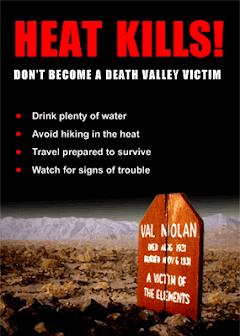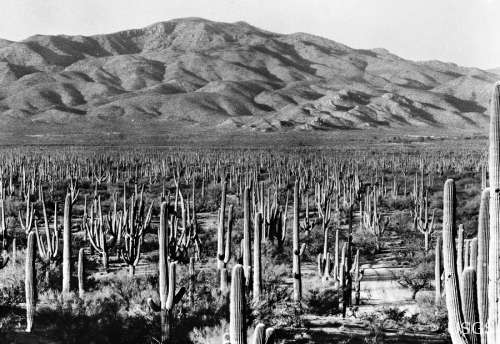death

Death Valley is the hottest place on Earth where the lowest temperature ever recorded in July stands at 69°F (21°C). The record highest temperature is almost twice that: 134°F (57°C). Only mad and Europeans visit outside the high season (November to March). 8am in October is the latest when you want to stay outdoors, and during hot autumn nights swimming pool may seem more inviting than your not-so-cheaply rented hotel bed.
vortex
Did they believe in vortexes as we do? asks 8-years old boy. We don’t know, USFS volunteer who shows us around the Palatki site patiently answers. This is a typical answer when it comes to ancient ruins and their builders in the American Southwest. The question however is only typical to Sedona where New Age belief in psychic influence of red phallic protrusions reins supreme. At least boy’s grandfather looks vaguely embarrassed.
oasis
Spending every afternoon in a swimming pool gives one a poor vantage point to criticize use of water, but Palm Springs’ 540 gallons per person per day is truly impressive. Despite its desert location this is a green place. Not green because of its environmental credentials. While over 3000 turbines of San Gorgonio Pass Wind Farm are an inspiring and a bit scary sight, Palm Springs is green in the original meaning of the word: green as trees, grass, golf courses and - obviously - palms. Which are no longer confined to occasional oases fed by natural springs.
sea
Have you ever wondered what happens to the Colorado river? If you look at a map it’s pretty clear where it begins, but not so obvious where it ends. There is a good reason for that: Colorado is pumped out dry and disappears long before it has a chance to reach its delta in the Sea of Cortez. If US did not have any other moniker it could be the country that kills its rivers. In an amazing display of newspeak, building dams and reservoirs is called water conservation. It’s as if water goes to waste if the river is allowed to continue to the ocean.
experiment
There must be something in the expanse of empty unusable land that invites experimentation. Faced with a desert I have an overwhelming desire to flee to an area with dependable source of water, but others see canvas to be filled with their idea of improved living. We visited three such experiments over couple of days. Chronologically the oldest one is Frank Lloyd Wright’s Taliesin West. Differently than all other Wright’s buildings this one does not really have unforgettable or revolutionary architecture. The most innovative thing about it is the use of local materials, simply rocks found on the desert embedded in concrete. Low structures on the brow of the hill were meant as workspaces. Originally they did not have glass windows. You don’t really need them on the desert; openings shaded with canvas are entirely sufficient. Built as winter campus of the traveling university, so called Wright’s fellowship, the complex is not that conceptually different from ancient Indian pueblos. What you are really after in the desert is to create shade, you get extra points for positioning your passageways to capture fleeting breeze cooled over shallow water pools. Of course now Taliesin has both windows and air conditioning but you still see the design behind an attempt to build a shelter at minimal cost. That’s the most revolutionary and sadly most ignored lesson to be learned from this experiment: using instead of fighting the desert.
saguaro

When you see the land covered by cacti: giant saguaros, stocky fish-hook barrels, sprawling prickly pears, thorny ocotillos, you see… pasture. At least when you are a 19th century rancher. It seems that for desperate owners of hungry cows anything greenish spells fodder. Never mind thorns that would make animal-rights activists cringe. And forget about damage to the environment; if saguaros begin to die as result of your grazing practices all you need is a convenient theory: they wither because of unseasonably cold winters and there is nothing one can do. The idea that cows trample young plants preventing cactus forest renewal cannot possibly be true.
volcano
Extinct volcanos are bound to be disappointing. We expect to arrive at the scene of a catastrophe. We end up admiring picturesque hills. I guess Pompeii is an exception: a city buried under ash, destructive power of the explosion preserving ancient artifacts for our benefit. I was thinking of Pompeii when touring Wupatki and Sunset Crater Volcano National Monuments. When the volcano here erupted sometime before 1100, Anasazi civilization was still very much present in the area. I envisioned pueblo-style buildings preserved in ash, hoping for something spared from well meaning, but misguided, 20th century archeologists. But this is not Pompeii. Inhabitants of Wupatki pueblo were not doing so great before the eruption. Porous desert soil, unable to hold water, was lacking nutrients due to over-cultivation. Ash from the volcano acted as a fertilizer and improved water-holding capacity of their fields. Researchers found imprints of corn ears in lava flow. The working hypothesis is that they were offerings intended to stop the eruption. But maybe we underestimate our predecessors: what if they knew the volcano was actually beneficial and fed it corn to keep it going?
forest
Unless you are more hardened to wonderful sights than I am, you will almost fancy yourself in some enchanted spot. You seem to stand on the glass of a gigantic kaleidoscope, over whose sparkling surface the sun breaks in infinite rainbows. You are ankle-deep in such chips as I’ll warrant you never saw from any other woodpile. What do you think of chips from trees that are red moss-agate, and amethyst, and smoky topaz, and agate of every hue? That is exactly the sort of splinters that cover the ground for miles here, around the huge prostrate trunks — some of them five feet through — from which Time’s patient ax has hewn them. Charles Fletcher Lummis wrote these words in 1892.
diversion
Every time I flush the toilet in Las Vegas, I feel like I just doubled my eco footprint. And it’s Earth Day so I am extra guilty. Not guilty enough to pack and leave of course. Well, make it: not sober enough. Spending couple days here is probably less Earth-friendly than driving from Boston to Los Angeles in our truck for no particular reason other than writing this blog. But if you are trying to understand this country, you can do much worse than ending up in the casino oasis.
sand
There is a place in New Mexico where you can sled down the hill of white sand. Differently from your normal beach sand this one is composed of small particles of gypsum, not quartz. We get here a day after a rare rain so dune surfing does not work that well, but we don’t complain. The view is stunning. A lot had to happen in the geological terms for all this to be possible. Rob, the ranger guiding the sunset stroll, patiently explains formation of the basin skillfully navigating between ignoring and entertaining 3 preteen boys. The rest of the group listens more appreciatively.
own
Texas has some wonderful laws: when you own the land you can pump out as much groundwater from underneath as you want. Comes really handy when your land is arid but you desire to grow some water thirsty lettuce or pecan trees. If that dries wells of your neighbors so be it. It’s about who has the biggest pump after all. Or when you don’t feel like farming at all, you can simply find a city in need of water and export water from the desert. Just invest in a diesel pump and some piping and the money will flow your way. Ingenious, huh?It doesn’t hurt to have a river or a stream flowing through your land. Just make sure you are upstream. In the case there are too many claims you have a better chance to use the water before the river dries up downstream.